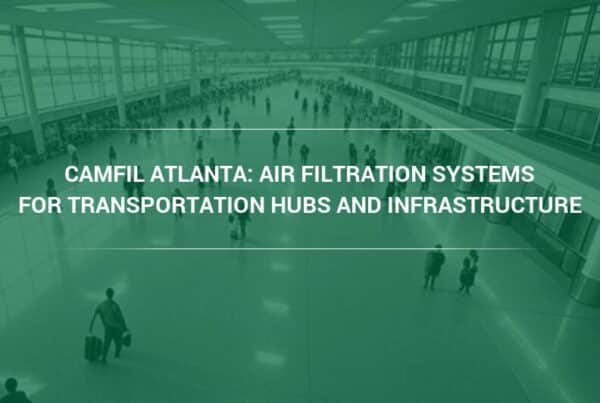Learn why pollution is affecting outdoor & indoor air quality in Maryland to a point that the government is looking to solutions other than air filters.
Last winter, Maryland residents found themselves exposed to high levels of air pollution. Local agencies issued alerts with recommendations for residents to stay indoors under the protection of air filters.
The polar vortex had caused temperatures in the state and the rest of the northeast to plunge to record low temperatures. For a short while, cities like Chicago were even colder than Antarctica. But with the cold also came another problem: air pollution.
A Code Orange air quality alert was issued by the National Weather Service (NWS) after air pollution in the region reached dangerous levels. On the air quality scale, Code Orange means that air quality is dangerous for children, the elderly, as well as individuals with existing health conditions—they are advised to limit the time spent outdoors.
The air quality scale is as follows:
- Green – Good
- Yellow – Moderate
- Orange – Unhealthy for sensitive individuals
- Red – Unhealthy for everyone
- Purple – Very unhealthy
- Dark purple – Hazardous/toxic
But why exactly did Maryland experience such a sudden decline in its air quality last winter?
Inversion to Blame for the Decline of Indoor Air Quality
Maryland’s sudden decline in outdoor and indoor air quality after the polar vortex had been caused by a weather condition known as an inversion.
Normally, temperatures become colder the higher one goes in the atmosphere. During an inversion, however, the opposite happens. This means that a layer of warm air high in the atmosphere keeps cooler air close to the ground. Without the constant mixing of upper and lower layers of air, emissions from traffic, factories, and power plants get trapped near the surface.
These emissions stagnate to a point where they snowball to create poor ambient or outdoor air quality. But the problem is that these emissions also affect indoor spaces.
“Outdoor air pollution infiltrates into buildings,” explains Camfil USA’s Mark Davidson, Manager of Marketing & Technical Materials for commercial and public building air filters.“Without appropriate ventilation, it accumulates and can even react with other indoor air pollutants.”
Inversions Show Why Air Filtration Systems Are ImportantWith climate change creating increasingly chaotic conditions every year, Maryland may have to brace for a future where extreme winters lead to worsening air quality, highlighting the importance of having air filtration systems.
This problem is by no means isolated to Maryland, by the way. Places like Salt Lake, Denver, and even Los Angeles all experience inversions due to a combination of topographical features and climate. And while air quality sirens tend to go off every summer in Maryland, residents are calling on the government to come up with a long-term solution that actually addresses air pollution at the source.
It’s here where experts are turning to European countries like France, Germany, and in particular, the Netherlands, for inspiration. These countries share something in common: they’re investing billions of dollars to cut their carbon emissions by as much as 30 percent by 2030.
How Air Filters Can Help
Air filters are designed to capture and remove particles and fumes from air pollution. In particular, they are designed to capture particulate matter (PM), which refers to a mix of solid particles and liquid droplets ranging from 1.0 to 10 microns in diameter. This is important because PM inhalation is a known case of respiratory issues. Worse, fine particulate matter, or PM equal to but no larger than 1 micron in diameter, can enter the deepest recesses of the lungs and cross into the bloodstream. When this happens, the particles can reach the body’s vital organs, leading to health issues such as diabetes, neurodegenerative disease, and even obesity.
Thinking Green and Going Beyond Air Filters
Other than air filters, one of many long-term solutions that protect people from air pollution is to push for cleaner and greener transport solutions, similar to what is being done in the Netherlands. The European nation provides tax benefits to drivers of hybrids and electric vehicles, waiving registration fees and road taxes.
Likewise, Norway offers similar tax benefits, but with the bonus of free parking and access to specific bus lanes, allowing drivers to bypass traffic. Unsurprisingly, Norway currently leads the world in the number of electric vehicles in use, with close to a third of all cars sold in the country is a hybrid or electric vehicle.
Fighting Climate Change Inversions with Air Filters and Purifiers
As the threat of climate change looms over the planet’s climate patterns, it’s feared that inversions may end up becoming increasingly common, leading to more air quality alerts in the future. This underscores the importance of having high efficiency air filters s in indoor spaces, ensuring that any outdoor emissions that make their way inside are quickly captured and removed.
To learn more about how air filters can improve indoor air quality in buildings and communities, talk to the team at Camfil USA. You can also browse through our product catalog to explore our solutions yourself or find a Camfil USA location near you.
Lynne Laake
Camfil USA Air Filters
T: 888.599.6620
E: Lynne.Laake@camfil.com
F: Friend Camfil USA on Facebook
Y: Watch Camfil Videos on YouTube
Source:



